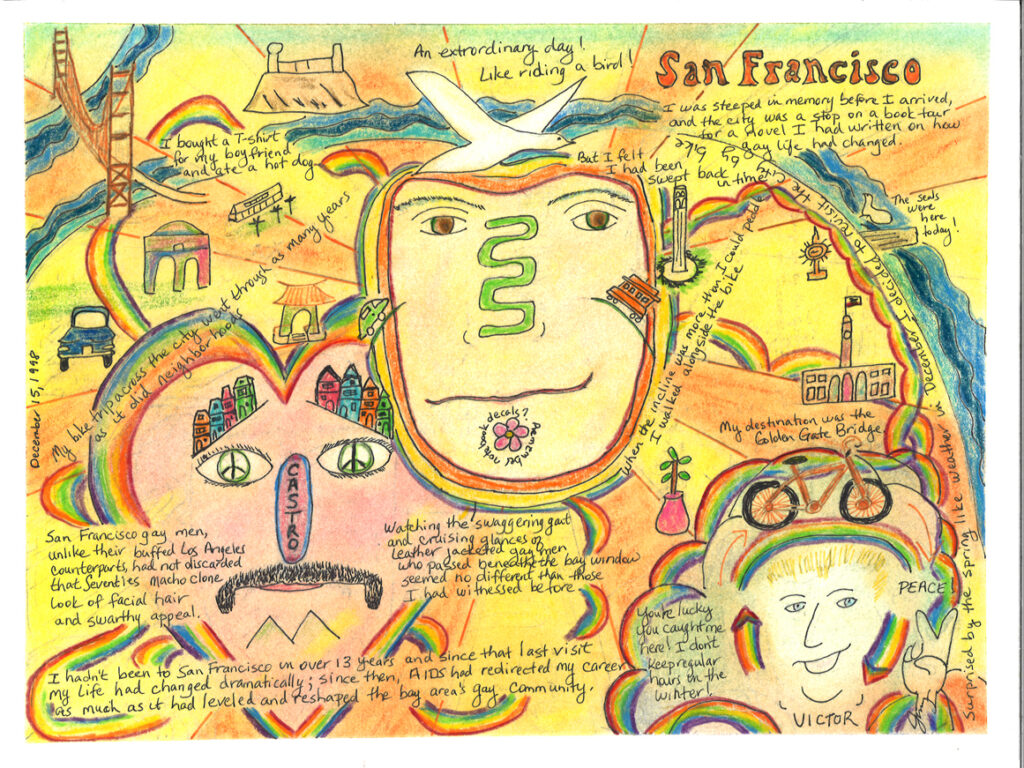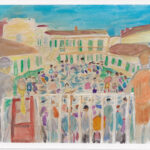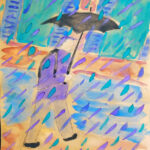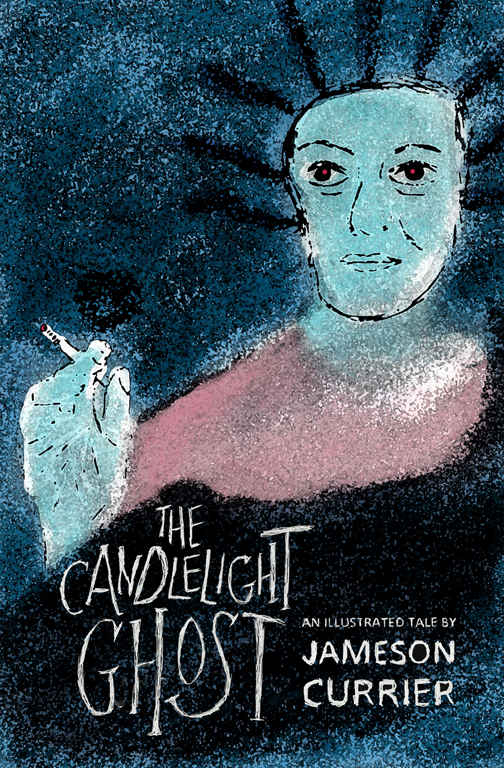
Magic Carpet Ride
Pencil, ink, and pastel
art by Jameson Currier
20180520001
Magic Carpet Ride
by Jameson Currier
I was steeped in memory before I arrived in San Francisco, having spent the weekend catching up with two college roommates who now lived in Los Angeles, reminiscing about our shared dinners of overcooked broccoli and our extra-curricular theatrics of overacted stage roles more than twenty years before. But I had started my trip sodden with personal recollection; Los Angeles and San Francisco were two stops on a book tour for a novel I had written which focused on gay life in the 1970s and 1980s and I was worried about being trapped too much in self-absorbed concentration.
But I hadn’t been to San Francisco in over thirteen years and since that last visit my life had changed dramatically; since then, AIDS had redirected my career as much as it had leveled and reshaped the bay area’s gay community. On this trip, however, I only expected to find San Francisco as a first-time tourist would: I was even anticipating visits to every traveler’s would-be destinations of Chinatown and Fisherman’s Wharf.
The notion of being swept back into time began when I unpacked in my room at the bed and breakfast inn I had chosen. At one end a bay window overlooked an intersection of streets and outside I could watch the random patterns of traffic and trolleys at the corners of Castro and Market. Watching the swaggering gait and cruising glances of leather jacketed gay men who passed beneath the window seemed no different, really, than those I had witnessed of their gay male counterparts over a decade before. San Francisco gay men, unlike their buffed Los Angeles counterparts, had not discarded that Seventies macho clone look of facial hair and swarthy appeal. Inside the inn, my room seemed to be stuck in a similar time warp. Three of the walls were painted white, but the fourth was colored a deep chocolate brown. Above a wicker desk, a framed poster of a vase of flowers hung, faded by years of light streaming in between two hanging baskets of plants. Beside the bed stood a large, custom-made mirrored armoire and cabinet. Track-lighting and navy blue-and-maroon linens reminded me of period details I might expect to find within an Armistead Maupin novel.
I expected to shake this heady pitch into reflection the following day when, buoyed by the surprising spring-like weather on the cusp of the winter solstice, I unexpectedly decided to see the city by bike.
“You’re lucky you caught me here,” the young operator of the bicycle shop said when I reached the Embarcadero and inquired about a rental. “I don’t keep regular hours in the winter.”
The young man must have been as surprised by the warmer-than-usual weather as I had been—he had shown up to work in summer clothes—a thin, white T-shirt which barely ended where his dark knee-length shorts began, a knotted strand of a leather string worn around his neck. He shook my hand and introduced himself as Victor and explained the terms and conditions of the rental as if I had only asked my brother to borrow his bike to make a quick trip to the store. He possessed that kind of Twilight Zone calm, and his spiky dyed-blond hair and ice blue eyes cast the spell of being someone familiar yet standing outside of time—like a catalog version of someone’s cool drinking buddy or hip college pal. I stood before him eager but unaware of the continued retrospection he would soon unknowingly unlock.
My destination that day was the Golden Gate Bridge, but my trip across the city went through as many years as it did neighborhoods and streets. I biked to Fisherman’s Wharf and Fort Mason, through the Presidio and down Lombard to Russian Hill, walking alongside the bike when the incline was more than I could peddle. Everywhere I went that day I encountered details of my personal past. On Polk Street, a large jade plant potted in a ceramic pot outside a restaurant reminded me of a plant I had kept in my first Manhattan apartment. On Jackson, a flower decal on the frame of a motorcycle was exactly the kind we used to paste onto notebooks in junior high school in the 1960s.
But a trip through San Francisco, I also discovered that day, is a trip through America’s pop cultural past, memory explodes into recognition in every inch of the city. The city easily evokes trends of other eras, from the beatniks to the hippies to the yuppies. On Filmore Street in Pacific Heights, an elegantly restored navy blue and white 1950s Bel Air was parked at the curb in a city where it’s not unusual to find several working versions of the original VW Bug passing you on the street. Renovated houses with gingerbread lattice and stained glass windows are exactly what you would expect to find in San Francisco, and they are right there, on Filmore and Hayes and Pierce. And so are the tie-dyed boutiques and psychedelic sandwich signs outside restaurants in the Haight. Even at the Tower Records outlet in Soma, the saleswoman behind the counter seemed to have been hired because she looked like an aged Joni Mitchell. By the time I decided to find my way to the Golden Gate Bridge, it seemed absolutely uncontrived that the young man with bushy black hair working outside his home on Fell Street should be listening to Steppenwolf’s “Magic Carpet Ride.”
At the bridge I succumbed to finally being a tourist, buying a T-shirt for my boyfriend at the gift shop, then eating a hot dog while propped up against the bike. Beyond me the city was a picture-perfect orb and a memory of sights. Hours later, when I had made my way back to the Embarcadero to return the bike, Victor was sitting outside his shop, shooting the breeze with a stubbly-bearded man wearing a red knit cap over his shoulder-length dreadlocks, an amalgamation of many fads.
I must have realized then that I was exhausted time traveler with a wild-eyed stare and jeans soggy with sweat that rode baggy around my hips, for Victor stood as I approached him as if he expected to catch me in a faint.
“Extraordinary day,” I said as he took the bike from me.
I’m sure he had no idea what crazy revelations had been floating through my mind all afternoon, but he nodded and looked out and up at the buildings cut-out against the still solid blue sky. “Like riding on a bird,” he answered.
As I started to leave he smiled and said “Peace,” then flashed me the universal sign of two fingers widened into a V. It seemed the perfect and natural way to end a day of nostalgia in San Francisco.
“Peace,” I answered back and then walked toward the traffic light, inching my way slowly back into the present.
___________
“Magic Carpet Ride” was written in 1998 following the author’s book tour for Where the Rainbow Ends. It was first published in his memoir, Until My Heart Stops (Chelsea Station Editions, 2015).





